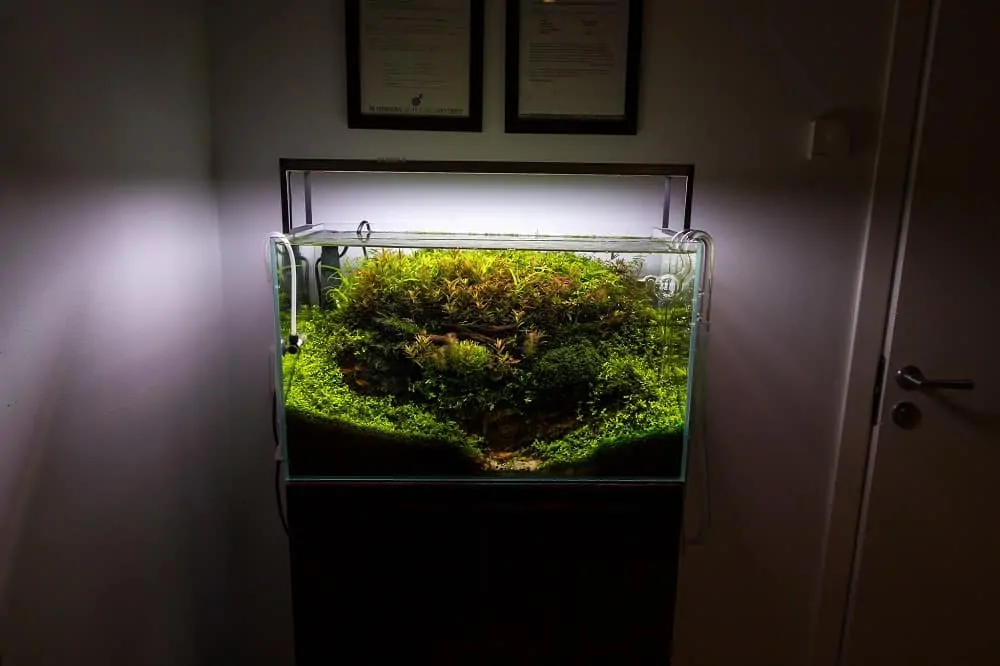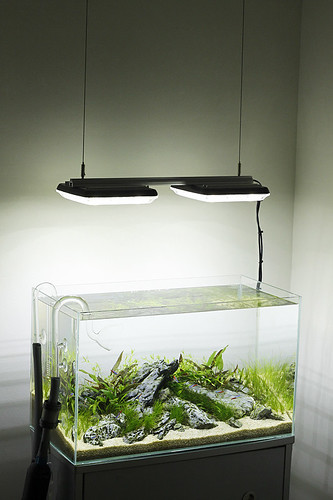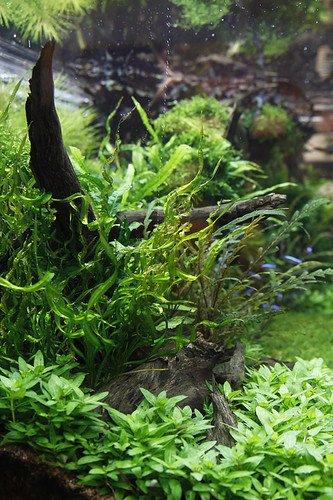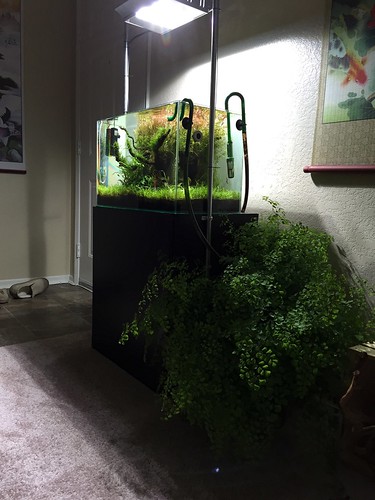Lighting is an important part of your aquarium. Not only does it make the entire tank look good, but it’s also highly important for your fish and plants. Proper lighting can bring out the best color of your aquarium inhabitants.
If you are new to this area it can seem quite complicated, but trust me: with the right information it will become easier than you’d think.
This article on aquarium lighting is a guest post by Expert Aquarist.
Introduction
As I said earlier, lighting has a great effect your aquarium, but choosing the wrong system can also have negative consequences. And that’s exactly why having proper lighting knowledge is mandatory. Therefore, in this freshwater aquarium lighting guide, I have covered lighting types, importance, features, plants lighting requirements and more.
Let’s get started.
Purpose of Lighting
Before we get on to the different lighting types and other information, it would be wise to give you a clear view of why your aquarium actually needs lighting.
One of the major purposes of aquarium lighting is the overall aesthetic. The right lighting will make your aquarium look stunning. There are some bulbs in the market especially made to enhance the color of aquarium fishes.
If you have a planted aquarium, then proper light is important for you. First of all, lights will increase the beauty of the plants by “putting them in the spotlight”. More importantly, plants use light as energy and your aquarium plants won’t be able to grow if they don’t get enough of it. They are completely dependent on the light to remain healthy – although different kinds of plants require different amounts of light.
Lastly, and very importantly, fish need a lighting cycle to thrive. The lights turning on and off tells them when to rest and when to be active. If you want to be able to see your nocturnal fish when they become most active, you can even install a moonlight in your tank!
Types of lighting sources
There are various kinds of lighting sources available, all matching for different needs. We’ll discuss some of the most popular types and their pros and cons.
Fluorescent bulbs
These are the most common traditional bulbs. They’re easy to find and there’s a fluorescent bulb for every tank. They can be found in all shapes and sizes, from the lowest wattage to the most powerful you’ll ever need.
The Pros
- Cheaper than other types of lights.
- Available everywhere.
- Helpful for plant growth.
- Very wide range of formats available for different tanks.
The Cons
- Delivers heat.
- Not so long lasting.
Metal Halide
This lighting type is relatively new to the aquarium world and very powerful. Metal halide light has a color temperature of 5500 to 6000K which duplicates the natural sunlight and makes it ideal for the freshwater aquarium. These are also suitable for reef tanks since these require a lot of light.
The Pros
- Penetrated deep and offers natural shimmering.
- Doesn’t take up much space.
- Consumes less energy.
- Lasts really long.
The Cons
- More expensive.
- Produces intense heat.
LED
LED lights are widely used aquarium lighting, for good reason. These lights are available in a large number of colors and also energy saving. Unlike others, these lights don’t produce that much heat.
LED’s create nice and penetrating light which can help both non-planted and planted aquariums. They give a nice color to the entire aquarium.
The Pros
- Requires less energy.
- Lasts long.
- Produces a very low amount of heat.
- Comes in a large number of colors.
- Offers natural shimmering.
The con
- Some models can be a little expensive, although there are also budget LEDs for low-tech aquariums.
Halogen
These lights are the modified version of traditional bulbs. Halogen lights also work by transferring electrical current via tungsten wire. But these lights are very powerful, perfect for large reef tanks. Halogen lights can serve for very long with the right use.
The Pros
- Highly powerful.
- Long lasting.
- Can be found anywhere.
- Reasonably priced.
The cons
- Delivers high amount of heat.
According to my research for planted aquariums, there is no better alternative than the LED. They are very safe to use since they don’t produce that much heat. Additionally, they come in a large variety of colors so you can choose your preferred one using a remote. On top of this they are energy efficient. I have seen most professional planted aquarium owners use LED lights.
Types of Plants and their lighting requirements
I have categorized plants into three broad categories: carpet, mid-ground and background plants. All types require different lighting levels, some require bright light and others survive on less. Let’s take a look.
Carpet plants
These plants mainly cover the base of the aquarium like carpets and that’s why these are called carpet plants. Carpeting plants look like a bed of grass. These plants are often quite demanding when it comes to lighting. Some carpet plants are:
Dwarf baby tears (Hemianthus callitrichoides): Baby tear is a popular aquarium plant which is famous for its vibrant natural look. They can grow nicely even in small aquariums, but do need a lot of light.
Glossostigma Elatinoides: These are another stunning carpet plant, probably one of the smallest. Like baby tears, these plants require very high light to prosper nicely.
Java Moss (Taxiphyllum barbieri): This is one of the most popular aquarium plants all over the world since they require low maintenance and grow quickly. These plants can can grow comfortably in low light, but do make a more challenging choice if you’re looking to create a carpet.
Lilaeopsis: Lilaeopsis grows fast and covers the entire aquarium base with green in very less time. For quick growth, Lilaeopsis should be in medium to high light.
Mid-ground plants
These plants usually require little maintenance and look stunning. They can make themselves comfortable at any space of the aquarium and work well as accent plants. Some examples are:
Green Tiger Lotus (Nymphaea zenkeri): The green tiger lotus doesn’t require a lot of specific care. In order to flourish nicely, they need a gentle amount of light, not too bright and nor too low.
Pygmy Chain Sword (Echinodorus tenellus): These plants are very similar to the grass we often see on the ground and perhaps that’s why they are so admired. They are perfect if you’re looking to imitate a terrestrial landscape and only need moderate lighting to thrive.
Anubias Nana: This is a smaller cousin of the very popular Anubias barteri, which is widely appreciated for its low lighting needs. Not a lot of maintenance nor strong lighting is needed to get this species to thrive.
Background plants
These plants hide equipment, add depth and create hiding places for freshwater fish. Some can grow up to 20″/50 cm. Examples of background plants are:
Amazon sword (Echinodorus sp.): A very easy to maintain plant that grows fast and can reach to the top of even the tallest tanks. They make the entire background area stand out. Low to medium amount of light works fine for these, so you don’t have to invest in an expensive lighting system.
Pondweed: They are also called Elodea Densa. This plant doesn’t have many requirements when it comes to care and can thrive in a wide variety of temperatures. Its growth rate depends on lighting, but like most stem plants it does look better in high light environments.
African water fern (Bolbitis heudelotii): Another impressive background plant that can be grown even by beginners. It requires a water temperature between 68 to 80 °F/20 to 26.5 °C and at least medium lighting to thrive.
Lighting information for Planted Tanks
Here I have tried to create a basic guideline about how much and how often you should give lights to your aquarium plants for better growth.
Lumen: Plants that require low light do fine on just 15 to 25 lumen. 25 to 50 lumen is for plants that need moderate light and above 50 works well for plants that require extra brightness. You can measure lumen, or light strength, using a light meter.
Lighting duration: Turning the lights on and off at the right time is highly important if you want your plants to grow nicely and keep your aquarium far from algae. Put your lighting system on a timer so that all the plants get the same amount of light every day at the same time. And don’t set the lighting period for more than 8 hours: too much light is a recipe for algae.
Amount of light: Giving your plants more than they need can scorch them and give birth to algae. So how much light do you need? Although the specific needs depend on whether you’re using LEDs or not and the depth of your tank, there are some general guidelines that you can keep in mind.
For plants that require low light, 0.25 watts per liter of aquarium water is likely sufficient. For medium lighting plants, 0.50 WPL is good and for plants that require high light, 0.80 WPL or more will work great.
Conclusion
I hope you enjoyed this Freshwater Aquarium Lighting Guide. However, if you have any kind of disagreement or any suggestion, don’t hesitate to leave a comment. Goodbye!








I have been pouring over info on the web to find an example of lighting I need for a planted 55 gal aquarium with high light demanding plants like baby’s tears or Montecarlo. There is a wealth of information but I can find nothing conclusive. I need examples of currently available, and hopefully affordable, 48 inch lights with or without a dimming features that I can purchase in the U.S. Can you help?
Hey Mike!
You’re bound to get many different answers when looking for lighting. I understand the struggle! I can’t give you specific models because that will depend on a few factors. But I personally like Hygger. Others like the Fluval 3.0 or Finnex.
I have read several articles on aquarium lighting. One topic missing is placement of the lights. Intensity of light will change with how close to the water the light fixture is. If the fixture is an above the tank strip fixture than moving the fixture to the front will create more depth or if tall plants are in the back, perhaps the light should be in the rear, however more tanks than ever have standard desk fixtures over the aquarium. Sometimes several feet above the aquarium. Full spectrum LED lights now come in several shapes and sizes, including submerged aquatic lights. The placement of the lighting is really not being discussed much – including safety. I am seeing photos of nano tanks with desk lighting perched over the water.
Hi Chris!
This is all true. Height above the tank has a lot to do with photosynthetic active radiation (PAR), desired/required light spread, and overall shading in the aquarium. Most hobbyists don’t need to run their lights anywhere near full power because the technology has advanced so much and we better understand which light frequencies are needed most for plants and corals to thrive. In all, there’s less of a guessing game with the equipment on our tanks. Hobbyists now have a larger selection of lights to choose from that can all work for the most part as long as they are emitting enough of those optimal frequencies.
You might not see a lot of articles talk about it because it really is specific to the light being used and the overall system, and of course, personal preference.